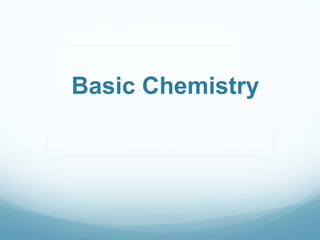Biochemistry--6.1 Basic Chemistry
•Download as PPT, PDF•
6 likes•1,972 views
Atoms, Elements and Compounds
Report
Share
Report
Share

Recommended
More Related Content
What's hot
What's hot (20)
Similar to Biochemistry--6.1 Basic Chemistry
Similar to Biochemistry--6.1 Basic Chemistry (20)
More from kathy_lambert
More from kathy_lambert (20)
6.4 organic compounds notes(teacher)for slideshare

6.4 organic compounds notes(teacher)for slideshare
Recently uploaded
https://app.box.com/s/7hlvjxjalkrik7fb082xx3jk7xd7liz3TỔNG ÔN TẬP THI VÀO LỚP 10 MÔN TIẾNG ANH NĂM HỌC 2023 - 2024 CÓ ĐÁP ÁN (NGỮ Â...

TỔNG ÔN TẬP THI VÀO LỚP 10 MÔN TIẾNG ANH NĂM HỌC 2023 - 2024 CÓ ĐÁP ÁN (NGỮ Â...Nguyen Thanh Tu Collection
Recently uploaded (20)
Unit-IV; Professional Sales Representative (PSR).pptx

Unit-IV; Professional Sales Representative (PSR).pptx
Jual Obat Aborsi Hongkong ( Asli No.1 ) 085657271886 Obat Penggugur Kandungan...

Jual Obat Aborsi Hongkong ( Asli No.1 ) 085657271886 Obat Penggugur Kandungan...
This PowerPoint helps students to consider the concept of infinity.

This PowerPoint helps students to consider the concept of infinity.
Unit-V; Pricing (Pharma Marketing Management).pptx

Unit-V; Pricing (Pharma Marketing Management).pptx
Seal of Good Local Governance (SGLG) 2024Final.pptx

Seal of Good Local Governance (SGLG) 2024Final.pptx
Basic Civil Engineering first year Notes- Chapter 4 Building.pptx

Basic Civil Engineering first year Notes- Chapter 4 Building.pptx
Micro-Scholarship, What it is, How can it help me.pdf

Micro-Scholarship, What it is, How can it help me.pdf
Russian Escort Service in Delhi 11k Hotel Foreigner Russian Call Girls in Delhi

Russian Escort Service in Delhi 11k Hotel Foreigner Russian Call Girls in Delhi
TỔNG ÔN TẬP THI VÀO LỚP 10 MÔN TIẾNG ANH NĂM HỌC 2023 - 2024 CÓ ĐÁP ÁN (NGỮ Â...

TỔNG ÔN TẬP THI VÀO LỚP 10 MÔN TIẾNG ANH NĂM HỌC 2023 - 2024 CÓ ĐÁP ÁN (NGỮ Â...
Kodo Millet PPT made by Ghanshyam bairwa college of Agriculture kumher bhara...

Kodo Millet PPT made by Ghanshyam bairwa college of Agriculture kumher bhara...
General Principles of Intellectual Property: Concepts of Intellectual Proper...

General Principles of Intellectual Property: Concepts of Intellectual Proper...
Biochemistry--6.1 Basic Chemistry
- 2. Why do we study chemistry in biology class? Because everything is made of different kinds of elements
- 3. What is Matter Made of? Answer; Atoms Atoms are composed of; a. Nucleus • Center of the atom • Contains protons (positive) & neutrons (neutral) b. Electron cloud • Surrounding the nucleus • Contains electrons (negative)
- 5. Atom
- 6. Elements An element is a pure substance that cannot be broken down into other substances by physical or chemical means. Made of only one type of atom
- 7. F.Y.I. 92 naturally occurring elements 26 found in living things Only 6 elements make up nearly the entire weight of an organism! 20 trace elements occur in your bodies.
- 8. Big “6” (Actually Big “4”) What happens when you mess up driving? People “HONC” at you! - Hydrogen (H) 10% of an animal’s weight - Oxygen (O) 63% of an animal’s weight - Nitrogen (N) 4% of an animal’s weight (Makes up genes and proteins) - Carbon (C ) 19% of an animal’s weight
- 9. The Big 6
- 11. Bonding forms Compounds 1. Elements can combine to form more complex substances. 2. Compounds are formed when two or more substances combine in a chemical bond. 3. There are two main types of bonds: o Ionic bonds o Covalent bonds 1. All bonds involve the atom’s electrons (particularly the outermost, valence, electrons)
- 12. 5. Why do elements want to bond together? Atoms want to have full energy levels, this makes them stable. Energy Levels are where the electrons are found- each level can hold a specific number of electrons Ex. 1st level = 2 electrons 2nd level = 8 electrons
- 13. Atoms become more stable by losing electrons or attracting electrons from other atoms - this results in a chemical bond.
- 14. Covalent Bonding Chemical bond formed when electrons are shared. Hint: Covalent = Cooperate Example: The oxygen atoms below are sharing their valence electrons in order to have a complete outer shell of electrons.
- 15. Ionic Bonding Created when atoms give up (donate) or obtain (accept) electrons to empty or fill the outer energy level. The atom that loses the electron(s) becomes positive The atom that gains the electron(s) becomes negative. Atoms that have a positive or negative charge are called Ions
- 16. Example of an Ionic Bond
- 17. Time for Questions! 1. What are the four main elements that make up living things? 2. When is an atom considered chemically stable? 3. What are the two main types of bonds that atoms form? 4. What is the main difference between the two types of bonds you listed above?